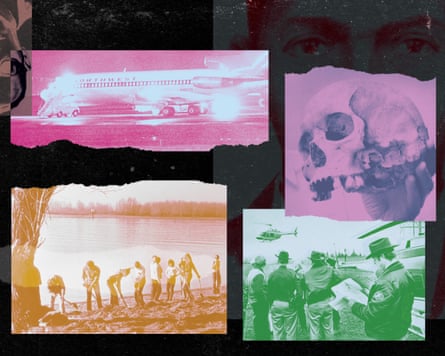On the evening of 24 November 1971, Florence Schaffner, a flight attendant on a Northwest Orient flight heading to Seattle, Washington, from Portland, Oregon, was handed a note by a male passenger seated at the back of the plane. Schaffner assumed the note was a phone number – this wasn’t the first time a passenger had hit on her – so she stowed it in her purse without reading it. The man leaned towards her and whispered: “Miss, you’d better look at that note. I have a bomb.”
Schaffner read it: “Miss – I have a bomb in my briefcase and want you to sit by me.”
She complied. The man was wearing a suit and had a dark complexion. His eyes were hidden by sunglasses. Schaffner watched as he opened his suitcase, revealing four cylindrical sticks connected to a wire and a battery – it certainly looked like a bomb. He then told Schaffner his demands: the passengers were to remain seated while the plane refuelled in Seattle; when he was handed $200,000 (about $1.6m today) and four parachutes, they would be released.
When the passengers alighted in Seattle, they had no idea they had just flown on a hijacked plane. The ground crew obeyed the hijacker’s wishes and refuelled the plane, while the authorities gave the cash and parachutes to the aircrew. The man then ordered the pilots to take off, flying low and slow with the flaps down towards Mexico.
At some point over Washington, the crew felt their ears pop when the pressure in the cabin dropped – someone had lowered the air stair at the rear of the plane. The man had leapt into the night and vanished, never to be found. The only trace he left behind was a clip-on tie, a tie clip and the name written on his ticket, Dan Cooper, which was misprinted in contemporaneous news reports as DB Cooper. The name stuck – and a legend was born.
No one knows who Cooper was (or is), not three-letter spooks or an army of amateur sleuths. The case is on ice, but the tale remains captivating. Leaving aside the audacity of the stunt, several questions persist: was Cooper never found because he didn’t survive the jump? The authorities recorded the serial numbers of the bills handed to Cooper, but they never showed up, except for about $5,800, discovered in a state of disintegration on the banks of the Columbia River near Vancouver, Washington, in February 1980. Who was Cooper? A former paratrooper or a chancer? Where was he from?
The answers to these questions seem maddeningly out of reach; I understand how greyhounds feel about mechanical rabbits.
Fly too close to this mystery and it sucks you into its orbit. Geoffrey Gray, who wrote the 2011 book Skyjack: The Hunt for DB Cooper, refers to this as the “Cooper curse”. The podcaster Darren Schaefer has the curse, too. He got it after reading Skyjack and felt compelled to start a podcast dedicated to the mystery with Russell Colbert in 2018. Schaefer was originally going to call it The DB Cooper Podcast, but ultimately landed on The Cooper Vortex, after learning how fellow Cooper anoraks describe the case.
Schaefer explains that he has promised a few times over the years to abandon Cooper, but, like Michael Corleone in The Godfather, just when he thinks he is out, he gets pulled back in. “The DB Cooper story is like the best book I’ve ever read in my whole life, but I’m missing the first and last chapters of the book. I only have the middle. There is no DB Cooper story before the hijacking and there really is none after. He only exists for about five hours.”
There are many theories about Cooper’s identity. The name itself is intriguing: Dan Cooper is the protagonist in a long-running Franco-Belgian comic book series, Les Aventures de Dan Cooper. The comics star a heroic test pilot in the Canadian air force – think Tintin meets Buck Rogers. Some of the plots share similarities with the hijacking, including parachuting from a plane and delivering a ransom in a knapsack. Coincidences – or something more? “If you robbed a train and then escaped on a skateboard and your ticket was under the name Tony Hawk, is that a coincidence?” asks Schaefer.

Was the hijacker inspired by the comics? The series was not well known outside the Francophone world; perhaps he was Canadian. If so, that would narrow the search to fewer than 2.9 million people, roughly the number of French Canadian males in 1971.
What about the money? Always follow the money, they say. Only the money leads nowhere. In more than 50 years, not a single bill from the ransom has appeared in circulation, despite the notes’ serial numbers being shared with banks across the US. (The money found in 1980 brought investigators no closer to the truth.)
The simplest explanation for what became of Cooper is that he failed to land safely; his body and loot were lost to the elements and the passage of time. This was the prevailing wisdom among the original FBI investigators. Cooper was wearing a suit and dress shoes and jumped into thick clouds and heavy rain on a freezing night above the Washington wilderness – not the best attire for parachuting or the hike he would have had to make upon landing.
Cooper instructed the pilots to fly towards Mexico, but he had no way of knowing the exact flight path they were taking, due to the dense cloud cover. The landscape of the Pacific Northwest is wildly diverse: Cooper could have plummeted into a crag on a mountain, plunged into a lake or crashed into a ravine just as easily as alighted softly on flat agricultural land.
But Marty Andrade is not convinced Cooper is dead. The Minnesota author has been following the Cooper mystery for more than a decade. In his book about the case, he argues that the statistics on parachuting survival rates favour Cooper. Importantly, he doesn’t believe Cooper jumped over wilderness.
“He probably jumped much closer to a town called Battle Ground, Washington,” Andrade says. “Now, there are a lot of trees and stuff, but it is well‑developed agricultural land, fairly flat compared with the Cascades [the mountain range that runs from southern British Columbia in Canada to northern California in the US]. And if you look at the timing of where the aircraft was, he may have landed within a mile or two of this town.”
Karen Humes, a professor at the University of Idaho’s department of earth and spatial sciences, agrees. With the help of her students, Humes created an interactive map of Cooper’s probable flight path and determined that he most likely parachuted over farmland. “It’s a complete myth that it was a wilderness,” she says. “We know it well enough to be confident that he jumped somewhere between Battle Ground, which is a very small town just north of Vancouver, Washington, and just barely south of the Columbia River. So, we’re talking the suburbs of Vancouver and the terrain is pretty flat.”
Whether or not he survived the jump is probably moot at this point. Cooper was thought to be about 40. If his behaviour on the flight provides a window into his lifestyle, then he was a heavy smoker and prone to taking absurd risks. As such, he is unlikely still to be alive.
“I accept the fact that we probably will never know; that’s fine with me,” says Andrade. The joy he takes from this mystery is the community around it. “It’s nice to be able to sit down and then just randomly start talking about why Cooper chose a felt-tip pen for his ransom note,” he says.
Andrade recalls the rabbit hole he went down when he learned that forensic analysts had found traces of metal particles on Cooper’s discarded tie. Andrade said the particles are found in makeup, which he discovered while poring over piles of research papers. “I’m reading all these papers and I’m like: ‘What am I doing?’”
Andrade, Humes and Schaefer have made many friends in this space, but things can get intense online, with people wrapping up their self-esteem in pet theories. Also, the community is a bit of a boys’ club. “I’m almost unique,” says Pat Boland over the phone from a cruise liner heading to the Portuguese coast. Along with Humes, Boland is one of the few women investigating DB Cooper. At 64, she is old enough to remember the hijacking being reported, but she says she got drawn into the vortex by the rumours swirling around the denouement of the TV series Mad Men. As the finale approached in 2015, it was posited that the series’ protagonist, Don Draper, would turn out to be Cooper. “Which, of course, did not happen. It was possibly a publicity stunt, but I started thinking about it again. And I just fell in headfirst.”
Boland has put together groups of researchers and scientists to try to convince the FBI to let them test Cooper’s parachute for DNA. Cooper tore up one of the parachutes he was given to create a makeshift bag for the ransom and left parts of it behind. “This would be at no expense to the taxpayer, as we have volunteers who are quite used to handling this type of evidence. Back in 1971, that type of testing didn’t even exist,” she says. The FBI has refused, but Boland remains hopeful that may change.
The Cooper case fits neatly into the true-crime genre, which is most popular among women, so why is Boland an outlier? “I think women tend to want to explain, for instance, the Zodiac killer or some horrible case, because they put themselves in the place of the victims,” she says. Men, on the other hand, identify with Cooper because his heist could have been written by Ian Fleming. “I think a lot of men would love to get an aeroplane and jump out with way over a million and disappear to Mexico with a margarita in their hand.”
The first sip from my drink makes the hairs on my neck stand up; a shiver snakes down my spine. It’s a bourbon and soda – the same cocktail Cooper sipped mid-flight – but here it’s called a Skyjack. I’m in DB Cooper’s, a Manhattan dive bar dedicated to the hijacking.
The bar was opened six months ago by the Irishman Ciaran Willis and two of his friends. Not wanting to be just another banal Irish pub – Celtic surnames, green snakes and shamrocks – they came up with a name that would stand out. As well as serving themed cocktails – the Flight 305 mixes pear vodka with pear nectar, blackberry and lemon juice – the pub is decorated with Cooper-inspired photos, drawings, newspaper clippings and T-shirts. “We’re running low on stuff at the minute,” Willis says as he gives me a tour. “These were the ones we did for St Patrick’s Day,” he continues, showing me a stack of green T-shirts. He leads me to the bar’s pièce de résistance: a giant framed poster illustrating the story of the hijacking. A Cooper convention takes place every year in Portland, Oregon; Willis is in touch with the organisers and says he hopes to host an event.
“Do you see him as a hero?” I ask Willis as he pours me another Skyjack. “I don’t really know how to answer that,” Willis says. “He didn’t hurt anyone, I guess. But I wouldn’t advocate for any kind of air piracy. I suppose it took balls to do what he did, but I wouldn’t be advocating for any copycats.”
Andrade is more emphatic: “He was definitely a crook,” he says. “I don’t make him a Robin Hood character … He definitely deserved to get caught. He got people killed.” Andrade is referring to the copycats who hijacked planes in the aftermath, some of whom died in their attempts. “And he destroyed lives, not intentionally, but that was the end result. There were consequences to this that were serious and meaningful. It’s not a victimless crime.”
Boland agrees: “All the women I’ve spoken to about it, they also think he’s a criminal. Because I think they tend to really sympathise with the air stewardesses.” Cooper drew two flight attendants into his orbit on Flight 305. After Schaffner took his note and instructions to the cockpit, Tina Mucklow sat with Cooper for the remainder of the flight and acted as a liaison between him and the rest of the crew. It was Mucklow who received the ransom; she was the only flight attendant on board when the flight left for Mexico.
Mucklow probably doesn’t need anyone’s sympathy. “I just moved on. Maybe that’s part of being young and resilient, but it was also part of what we train for. That was part of what our job was,” she told Rolling Stone in 2021. The only trouble she has had is batting away the hordes of amateur Columbos who pursue her for interviews.
Schaefer has a different view. “I want to know the answer so badly I would do anything if somebody came to me and said: ‘Hey, I have all the secrets and I’ll tell you, but you can never tell anyone else.’ I would 1,000,000% say: ‘Yes, absolutely, tell me what happened, so I can know.’”
We live in an era of information overload. Facts flow like water and are just as difficult to control. It’s encouraging that there are still some mysteries left in a world where all the maps are charted. If Schaefer found Cooper, there would be no need for his podcast, no need for Andrade to discuss the finer details of felt-tip pens with his friends, no more conventions to attend, no more novelty bars. Not knowing seems the whole point of this mystery. Who is DB Cooper? Whomever you want him to be.

 2 months ago
84
2 months ago
84

















































